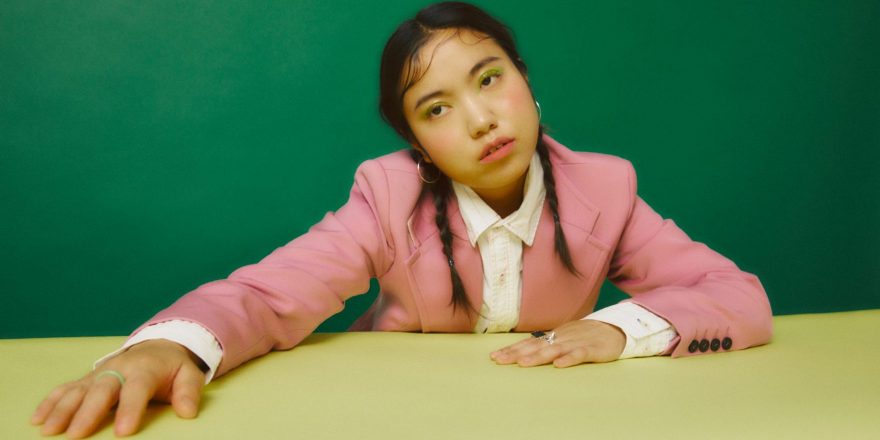The inspiration behind the lyrics to “Orchid Underneath” came in the form of a storm on the beach. What started as a peaceful sunset-viewing experience, enjoying a slice of pizza and a peach iced tea on the sand, quickly became treacherous. But though the clouds turned brown like sandpaper, then dark gray, the sky maintained a soft, lilac hue — foreboding and inviting. As the storm picked up abruptly and ferociously with hailstones, booming thunder, and lightning strikes, I wasn’t afraid. I felt excited, knowing I was in the presence of something truly awesome.
I ran to the car and drove on. I cherished the sense that something chaotic and brutal also possessed delicate beauty, and that I fit into this mysterious surprise somehow.
Listeners of “Orchid Underneath” might be surprised to learn that I played trumpet before I ever played a synth. I was lauded through middle and high school, and partook in orchestras, jazz ensembles, funk and psych rock bands. But my ability to play strangely disintegrated freshman year of college, just when I hoped to finally take New York City on as a jazz musician. I found myself in a new wilderness of musician-identity-collapse, and I retreated to piano and my voice.
It was in this low emotional point when an idea hit me — perhaps I could create something like MGMT? Or Thundercat? Maybe something like Caroline Polachek? Trumpet, a 10-year escapade, became irrelevant to me, and quickly so did many other interests. Piano and vocals, which had always been at the periphery, became songwriting tools to be transferred into a DAW and manipulated as electronic recordings. Something eclectic, emotional, and technological, another storm on the horizon, was brewing in a very deep way.
In the midst of the tumult, I discovered dance pop. My friend made me a “pop isn’t dead” playlist with lots of OLIVER production on it, including both of their solo projects and production for Turn off the Light by Kim Petras. I was completely infatuated with the sound and pocket of their work, and I felt a new burn to do something like it. Coming from a background of ensemble playing and disconnected songwriting endeavors, dance-focused music presented a new world.
Prior to my dance-pop fixation, my compositions built off of my fascination with groove and jazz-influenced music, distinguished by its color and its challenging song forms, dissonance, and rhythms. I was listening to composer/producer/improvisers like Louis Cole, Outside World, Flying Lotus, Clown Core, and Jacob Mann Big Band, driven by the animated and exploratory feeling particularly deriving from LA’s jazz scene. I gravitated towards what I categorize as a dance strain of contemporary jazz; this new genre might be called electronic jazz, which encompasses the electronic, pop, and dance aesthetics of the scene.
I started to notice the parallels between my longtime love of jazz and this burgeoning fascination with pop music. Gradually, I moved from dance pop towards hyperpop and its aesthetics — industrial, bright, distorted, high-drama. I found myself both surprised and enthralled by how it aligned with what I loved in contemporary jazz. ARTPOP by Lady Gaga stayed on repeat, as did Skrillex and 100 gecs. SOPHIE was paramount and became one of my favorite musicians altogether. Soon, I started seeing hyperpop and electronic jazz as crazy younger siblings of dance pop, variations that take on an unruly, whimsical, sometimes tongue-in-cheek character. The songs were adventurous and wide-ranging, appearing to rip themselves apart at the seams while coming together with searing structure. And in their boundary-breaking chaos, they were beautiful!
As I see it, musicians in both genres use their craftsmanship to “make fun” of pop. Not in a teasing way, but in a playful and almost trickster-ish sense of wanting to loosen up the preconceptions of mainstream pop and maximize on the exulting feelings that music can conjure. The serious aspect of both jazz musicianship and electronic dance production is only its diligence about playfulness — they are serious about play. The virtuosity is in service to euphoria; the hard work goes into creating a looser, more liberated sense of what a song can accomplish. Hyperpop and dance/electronic jazz take this serious playfulness to an extreme. Coming from a playing background on an instrument that I was good at, but never really loved, I felt the luminaries in both genres revealing a way forward for me where fun and enjoyment were valid, meaningful priorities.
One day, the 13-beat chorus of “Orchid Underneath” came into my mind; I counted the beats and the measures were 4/4, 5/4, 4/4. The unusual rhythm structure felt natural, exciting, and fresh. Serendipitously, a chorus that combined my two loves, dance-pop and electronic jazz, came alive. Once again, I felt that beach-storm sense — of fitting into the mystery, delighting in what is alluring, unexpected. I wrote in response to the storm what I might also say about the unpredictable and enjoyable arc of my music inspiration:
“All I hear is hail and metal clanging/But lavender winds have a pretty stare/Feet to crown I am electrified/Because deep below I want to be there”





